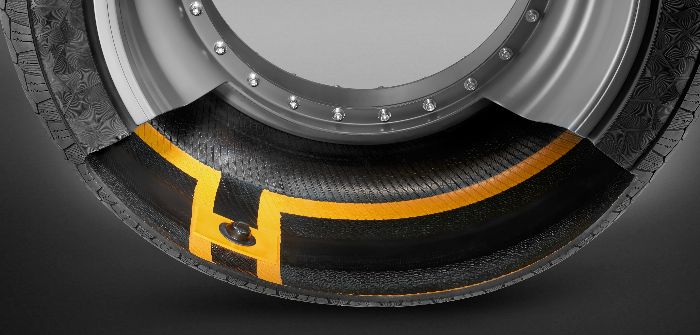Conti unveiled two new intelligent concepts at the Frankfurt Motor Show in Germany last week, which enable the continuous monitoring of the tire’s condition, as well as adaptation of tire performance characteristics to prevailing road conditions.
ContiSense is based on the development of electrically conductive rubber compounds that enable electric signals to be sent from a sensor in the tire to a receiver in the car. Rubber-based sensors continuously monitor both tread depth and temperature.
If the measured values are above or below predefined limits, the system alerts the driver. If anything penetrates the tread, a circuit in the tire is closed, also triggering an immediate warning for the driver – faster than the systems used to date, which only warn the driver when the tire pressure has already begun to fall.
In the future, the ContiSense system will feature additional sensors that can also be utilized individually. Thus information about the road surface, such as its temperature or the presence of snow, can be ‘felt’ by the tire and passed on to the driver. The data can be transmitted to the vehicle electronics or via Bluetooth to a smartphone.
ContiAdapt combines micro-compressors integrated into the wheel to adjust the tire pressure with a variable-width rim. The system can thus modify the size of the contact patch, which under different road conditions is a decisive factor for both safety and comfort.
Four different combinations allow perfect adaptation to wet, uneven, slippery and normal conditions. For example, a smaller contact patch combined with high tire pressure makes for low rolling resistance and energy-efficient driving on smooth, dry roads.
By contrast, the combination of a larger contact patch with lower tire pressure delivers high grip on slippery roads. The system also permits very low tire pressures of below 1 bar to be set, to help ease the vehicle out of a parking space in deep snow, for example, or traverse a dangerous stretch of black ice.
ContiSense and ContiAdapt are joined by a concept tire that enables the benefits of both systems to be fully leveraged. The tire design features three different tread zones for driving on wet, slippery or dry surfaces. Depending on the tire pressure and rim width, different tread zones are activated and the concept tire adopts the required ‘footprint’ in each case.
More in the November issue of Tire Technology International.
September 19, 2017



